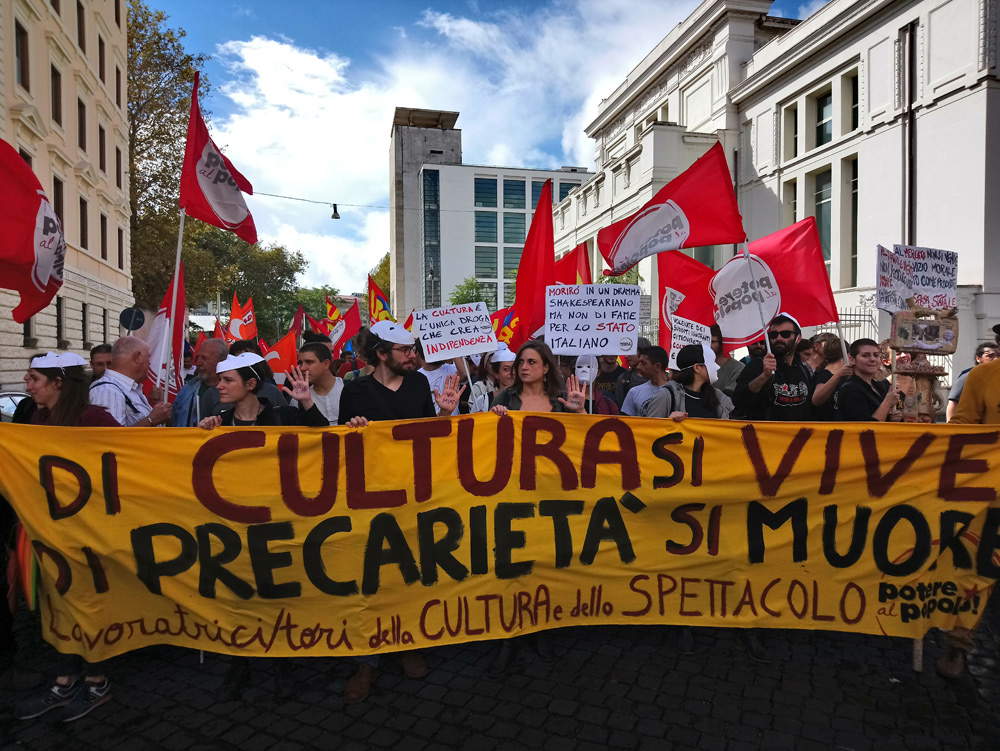There is a lot going on in the Italian cultural sector in terms of labor struggles, and not only related to the noisy protests in the entertainment industry in the months following the 2020 lockdowns, which have garnered considerable media coverage. Analyzing the past months and years, there is a visibly upward trend in labor disputes and strikes in museums and libraries. Certainly, the days are very far away when, after three months of strikes and closures to the bitter end, in 1971 Parliament asked the government for the creation of a Ministry of Cultural Heritage, reforms and hiring, which in fact would come in the following years, leaving an indelible mark on the protection and enhancement of the national cultural heritage. But the days when a swaggering Minister Franceschini, in October 2015, could declare in the newspapers that "the measure is full," and new regulations to limit strikes and union rights in the sector, after a banal assembly at the Colosseum, which was, moreover, authorized and completely in accordance with the law, also seem very distant. While the "Colosseum decree" certainly prevented places from closing due to strikes, forcing workers to be preempted to guarantee opening (although severe staff shortages did not prevent some museums from having to close anyway due to others’ strikes, as at the Galleria dell’Accademia last October), it does not seem to have diminished the tenacity of exploited workers who, here and there, in recent years seem to have reared their heads again after a decade of reflux.
Without wanting to get to the so far exceptional case of the double strike recorded between February and March in the Florentine civic libraries and archives, which involved citizens and local newspapers and whose outcomes are still unknown, but which is already inspiring emulators around Tuscany, there are many other disputes that have enlivened the sector in recent months, usually limited to the “state of agitation” (a process that forces the two sides to meet). In 2021, in no particular order and without any claim to exhaustiveness, we have recorded, in the part of the year when museums remained open, a state of agitation followed by collective abandonment of work in Montebelluna (Treviso); one in Forlì, against the dismissal of some workers due to a change of contract; one in Venice, against layoffs; one in Rome, to demand better conditions from the investee company Zètema; in Apulia, against announced layoffs; in Pompeii, Sicily... and then in December came ones in Genoa and Florence, in addition to the Florentine dispute mentioned above that later resulted in two strikes. Certainly the list is much longer. The year 2022 opened with the Florentine strikes, with the reopening of disputes not closed in previous years, but we have already recorded the state of unrest proclaimed at the Isontina State Library (Gorizia). And then at the Civic Museums and Libraries of Milan and Trieste: in both cases we are dealing with workers framed by the contract for fiduciary services, which is unfair for the role and indecent in compensation (about 5 euros gross per hour), and although the numbers are different (200 in Milan, a few dozen in Trieste) these are disputes that, given also the reactions of local administrations, may result in further mobilizations. That could in turn create emulators.

There was no shortage of precedents, with the strike of Turin’s civic museum workers in 2017 or the national state of agitation of Sistema Museo cooperative workers that had characterized 2020, and many others. Some of the disputes mentioned had been going on for years. But while the outcome of these disputes varies, and only in a few cases can these workers say they have “won” (but there is no shortage, as in the case of Napoli Sotterranea or the conviction for illegal labor brokering at the Fondazione Musei Civici in Venice), the motives driving these workers to take action are similar: The desire to get more, but above all the feeling that they have nothing to lose in the face of totally indecent wages and contracts and the constant threat of a change of contract. A situation of widespread frustration and despair that seems to have blown up the mechanism of blackmail and fear that for about thirty years had ensured that rights and wages were lowered without finding strong opposition from unions and the workers themselves. One should not imagine a season of major strikes just around the corner: the extreme parcelization of unions and workers themselves continues to make unity similar to what existed until a few decades ago difficult. But a new innovative activation process appears to be underway.
If on this May 1 there will be no “The Fourth Estate” in the Museums of Milan (moved to Florence for an exhibition event), it seems that in the same corridors those sentiments and conditions are emerging again, much more than Minister Franceschini expected in 2014, when he declared convinced: “when you keep a thousand or two thousand tourists in line, after they have booked their tickets months before, with all the spotlights of the world on them, to have a union meeting three days in a row, it is clear that you are not exercising a right but trying to create a problem, and you are also harming the country.” The same tourists who between 2020 and 2021 found those places closed for months on end, while the same workers were laid off and the bars were open.
Warning: the translation into English of the original Italian article was created using automatic tools. We undertake to review all articles, but we do not guarantee the total absence of inaccuracies in the translation due to the program. You can find the original by clicking on the ITA button. If you find any mistake,please contact us.